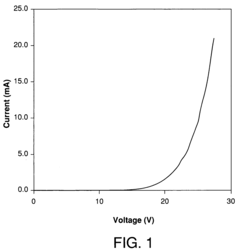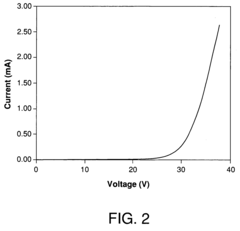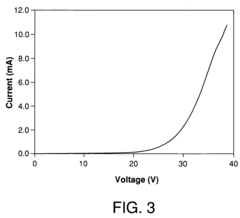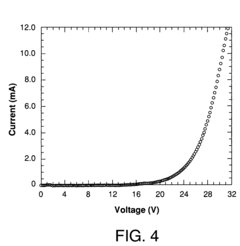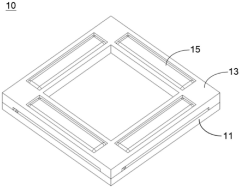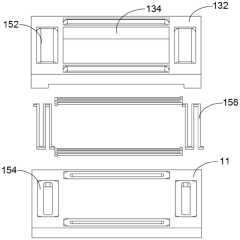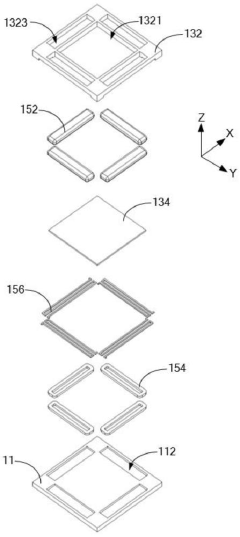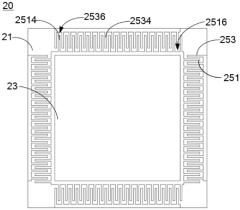ULED's Potential in Reshaping Consumer Habits
JUN 20, 20259 MIN READ
Generate Your Research Report Instantly with AI Agent
Patsnap Eureka helps you evaluate technical feasibility & market potential.
ULED Technology Evolution
ULED (Ultra Light Emitting Diode) technology has undergone significant evolution since its inception, marking several key milestones in display technology. The journey began with the development of traditional LED displays, which laid the foundation for ULED's emergence. As researchers sought to enhance display quality while reducing energy consumption, ULED technology emerged as a promising solution.
The early stages of ULED development focused on improving light emission efficiency and color accuracy. Scientists worked on refining the semiconductor materials used in the diodes, experimenting with various compounds to achieve brighter and more vibrant displays. This phase saw the introduction of quantum dot technology, which greatly enhanced color reproduction and expanded the color gamut.
A crucial breakthrough came with the miniaturization of LED chips, enabling higher pixel densities and improved resolution. This advancement paved the way for ULED's application in larger screens and high-definition displays. Concurrently, efforts were made to reduce power consumption, making ULED an attractive option for energy-efficient devices.
The next phase of ULED evolution centered on addressing challenges related to manufacturing scalability and cost-effectiveness. Innovations in production techniques, such as advanced lithography and thin-film deposition methods, allowed for more efficient and economical mass production of ULED panels. This development was pivotal in bringing ULED technology to the consumer market.
Recent advancements have focused on enhancing ULED's performance in areas such as contrast ratio, viewing angles, and response times. The integration of local dimming technology has significantly improved contrast levels, while new pixel structures have expanded viewing angles without compromising color accuracy. Additionally, researchers have made strides in reducing motion blur, making ULED displays increasingly suitable for fast-paced content like sports and action movies.
The latest frontier in ULED evolution involves the incorporation of artificial intelligence and machine learning algorithms. These technologies enable real-time image processing and optimization, further enhancing picture quality and energy efficiency. Smart ULED displays can now adapt to ambient lighting conditions and viewer preferences, providing a more personalized and immersive viewing experience.
As ULED technology continues to evolve, it is increasingly reshaping consumer habits and expectations. The superior image quality, energy efficiency, and versatility of ULED displays are driving adoption across various sectors, from home entertainment to digital signage and automotive displays. This technological progression is not only transforming the visual experience but also influencing how consumers interact with and perceive digital content in their daily lives.
The early stages of ULED development focused on improving light emission efficiency and color accuracy. Scientists worked on refining the semiconductor materials used in the diodes, experimenting with various compounds to achieve brighter and more vibrant displays. This phase saw the introduction of quantum dot technology, which greatly enhanced color reproduction and expanded the color gamut.
A crucial breakthrough came with the miniaturization of LED chips, enabling higher pixel densities and improved resolution. This advancement paved the way for ULED's application in larger screens and high-definition displays. Concurrently, efforts were made to reduce power consumption, making ULED an attractive option for energy-efficient devices.
The next phase of ULED evolution centered on addressing challenges related to manufacturing scalability and cost-effectiveness. Innovations in production techniques, such as advanced lithography and thin-film deposition methods, allowed for more efficient and economical mass production of ULED panels. This development was pivotal in bringing ULED technology to the consumer market.
Recent advancements have focused on enhancing ULED's performance in areas such as contrast ratio, viewing angles, and response times. The integration of local dimming technology has significantly improved contrast levels, while new pixel structures have expanded viewing angles without compromising color accuracy. Additionally, researchers have made strides in reducing motion blur, making ULED displays increasingly suitable for fast-paced content like sports and action movies.
The latest frontier in ULED evolution involves the incorporation of artificial intelligence and machine learning algorithms. These technologies enable real-time image processing and optimization, further enhancing picture quality and energy efficiency. Smart ULED displays can now adapt to ambient lighting conditions and viewer preferences, providing a more personalized and immersive viewing experience.
As ULED technology continues to evolve, it is increasingly reshaping consumer habits and expectations. The superior image quality, energy efficiency, and versatility of ULED displays are driving adoption across various sectors, from home entertainment to digital signage and automotive displays. This technological progression is not only transforming the visual experience but also influencing how consumers interact with and perceive digital content in their daily lives.
ULED Market Demand Analysis
The market demand for Ultra Light Emitting Diode (ULED) technology is experiencing significant growth, driven by the increasing consumer appetite for high-quality, energy-efficient display solutions. As consumers become more discerning about their visual experiences, ULED has emerged as a promising technology that offers superior picture quality, enhanced brightness, and improved energy efficiency compared to traditional LED and OLED displays.
The global display market, which ULED is poised to disrupt, is projected to expand substantially in the coming years. This growth is fueled by the rising adoption of advanced display technologies in various sectors, including consumer electronics, automotive, and digital signage. ULED's potential to deliver exceptional visual performance while consuming less power positions it as a compelling option for manufacturers and consumers alike.
In the consumer electronics segment, there is a growing demand for larger, higher-resolution displays with improved color accuracy and contrast ratios. ULED technology addresses these requirements by offering enhanced picture quality and energy efficiency, making it particularly attractive for high-end televisions, monitors, and mobile devices. The automotive industry is also showing increased interest in ULED technology for in-vehicle displays, as it can provide better visibility and readability in various lighting conditions.
The market trend towards sustainable and eco-friendly technologies further bolsters the demand for ULED. As consumers become more environmentally conscious, the energy-saving capabilities of ULED displays are likely to become a significant selling point. This aligns with global initiatives to reduce carbon footprints and promote energy-efficient products across industries.
Another factor driving market demand is the potential for ULED to reshape consumer habits in content consumption. The superior visual quality offered by ULED displays could lead to increased engagement with high-resolution content, potentially influencing the production and distribution of 4K and 8K media. This, in turn, could create a positive feedback loop, further stimulating demand for ULED-equipped devices.
The commercial and professional sectors also present significant opportunities for ULED technology. Digital signage, control room displays, and professional-grade monitors could benefit from ULED's ability to deliver high brightness and contrast ratios while maintaining energy efficiency. This could lead to wider adoption in retail environments, transportation hubs, and corporate settings.
As ULED technology continues to mature and production costs decrease, it is expected to penetrate more price-sensitive market segments. This expansion could lead to a broader consumer base and accelerated market growth. However, the rate of adoption will depend on factors such as manufacturing scalability, cost competitiveness, and the ability of ULED to differentiate itself from other emerging display technologies.
The global display market, which ULED is poised to disrupt, is projected to expand substantially in the coming years. This growth is fueled by the rising adoption of advanced display technologies in various sectors, including consumer electronics, automotive, and digital signage. ULED's potential to deliver exceptional visual performance while consuming less power positions it as a compelling option for manufacturers and consumers alike.
In the consumer electronics segment, there is a growing demand for larger, higher-resolution displays with improved color accuracy and contrast ratios. ULED technology addresses these requirements by offering enhanced picture quality and energy efficiency, making it particularly attractive for high-end televisions, monitors, and mobile devices. The automotive industry is also showing increased interest in ULED technology for in-vehicle displays, as it can provide better visibility and readability in various lighting conditions.
The market trend towards sustainable and eco-friendly technologies further bolsters the demand for ULED. As consumers become more environmentally conscious, the energy-saving capabilities of ULED displays are likely to become a significant selling point. This aligns with global initiatives to reduce carbon footprints and promote energy-efficient products across industries.
Another factor driving market demand is the potential for ULED to reshape consumer habits in content consumption. The superior visual quality offered by ULED displays could lead to increased engagement with high-resolution content, potentially influencing the production and distribution of 4K and 8K media. This, in turn, could create a positive feedback loop, further stimulating demand for ULED-equipped devices.
The commercial and professional sectors also present significant opportunities for ULED technology. Digital signage, control room displays, and professional-grade monitors could benefit from ULED's ability to deliver high brightness and contrast ratios while maintaining energy efficiency. This could lead to wider adoption in retail environments, transportation hubs, and corporate settings.
As ULED technology continues to mature and production costs decrease, it is expected to penetrate more price-sensitive market segments. This expansion could lead to a broader consumer base and accelerated market growth. However, the rate of adoption will depend on factors such as manufacturing scalability, cost competitiveness, and the ability of ULED to differentiate itself from other emerging display technologies.
ULED Technical Challenges
ULED (Ultra Light Emitting Diode) technology faces several significant technical challenges that need to be addressed before it can fully realize its potential in reshaping consumer habits. One of the primary hurdles is the development of efficient and stable blue ULED emitters. While red and green ULEDs have shown promising results, blue ULEDs still lag behind in terms of efficiency and longevity, which is crucial for achieving a full-color display.
Another major challenge lies in the manufacturing process of ULEDs. The current production techniques are complex and costly, making it difficult to scale up for mass production. The precision required in fabricating these ultra-small light-emitting structures demands advanced lithography and deposition techniques that are not yet fully optimized for large-scale manufacturing.
Heat management is also a significant concern for ULED technology. As these devices are designed to operate at high current densities to achieve ultra-high brightness, they generate substantial heat. Developing effective heat dissipation mechanisms without compromising the device's ultra-thin profile is a critical challenge that researchers are actively working to overcome.
The integration of ULEDs into flexible and transparent displays presents another set of technical hurdles. Creating bendable and transparent substrates that can withstand the manufacturing processes and maintain the performance of ULEDs is an ongoing area of research. This challenge is particularly important for applications in wearable technology and augmented reality displays.
Achieving uniform light emission across large ULED arrays is another technical obstacle. As display sizes increase, ensuring consistent brightness and color across all pixels becomes more challenging. This requires advancements in both manufacturing precision and driving circuitry design.
The development of efficient and stable quantum dot color conversion layers for ULEDs is also a key area of focus. These layers are essential for achieving a wide color gamut and high color purity, but current materials often suffer from degradation issues that limit the long-term performance of ULED displays.
Lastly, the challenge of reducing power consumption while maintaining ultra-high brightness is crucial for the widespread adoption of ULED technology, especially in mobile devices. Balancing these competing requirements demands innovations in both materials science and device architecture.
Addressing these technical challenges will be critical in enabling ULED technology to revolutionize display technology and potentially reshape consumer habits through its applications in various fields, from mobile devices to automotive displays and beyond.
Another major challenge lies in the manufacturing process of ULEDs. The current production techniques are complex and costly, making it difficult to scale up for mass production. The precision required in fabricating these ultra-small light-emitting structures demands advanced lithography and deposition techniques that are not yet fully optimized for large-scale manufacturing.
Heat management is also a significant concern for ULED technology. As these devices are designed to operate at high current densities to achieve ultra-high brightness, they generate substantial heat. Developing effective heat dissipation mechanisms without compromising the device's ultra-thin profile is a critical challenge that researchers are actively working to overcome.
The integration of ULEDs into flexible and transparent displays presents another set of technical hurdles. Creating bendable and transparent substrates that can withstand the manufacturing processes and maintain the performance of ULEDs is an ongoing area of research. This challenge is particularly important for applications in wearable technology and augmented reality displays.
Achieving uniform light emission across large ULED arrays is another technical obstacle. As display sizes increase, ensuring consistent brightness and color across all pixels becomes more challenging. This requires advancements in both manufacturing precision and driving circuitry design.
The development of efficient and stable quantum dot color conversion layers for ULEDs is also a key area of focus. These layers are essential for achieving a wide color gamut and high color purity, but current materials often suffer from degradation issues that limit the long-term performance of ULED displays.
Lastly, the challenge of reducing power consumption while maintaining ultra-high brightness is crucial for the widespread adoption of ULED technology, especially in mobile devices. Balancing these competing requirements demands innovations in both materials science and device architecture.
Addressing these technical challenges will be critical in enabling ULED technology to revolutionize display technology and potentially reshape consumer habits through its applications in various fields, from mobile devices to automotive displays and beyond.
Current ULED Solutions
01 ULED display technology advancements
Ultra Light Emitting Diode (ULED) technology has seen significant advancements in display applications. These improvements include enhanced brightness, color accuracy, and energy efficiency, leading to increased consumer adoption in various electronic devices such as smartphones, televisions, and monitors.- ULED display technology advancements: Ultra Light Emitting Diode (ULED) technology has seen significant advancements in display applications. These improvements include enhanced brightness, energy efficiency, and color reproduction, leading to better viewing experiences for consumers. ULED displays are being integrated into various consumer electronics, influencing purchasing decisions and usage patterns.
- ULED lighting solutions for consumer spaces: ULED technology is being applied to lighting solutions for consumer spaces, offering improved illumination quality and energy efficiency. These lighting solutions are impacting consumer habits in home and office environments, with users appreciating the customizable brightness and color temperature options.
- ULED in automotive applications: The adoption of ULED technology in automotive lighting and displays is influencing consumer preferences in vehicle selection. ULED headlights, taillights, and interior lighting offer improved visibility, energy efficiency, and design flexibility, contributing to enhanced safety and aesthetics in automobiles.
- ULED in mobile devices: ULED technology is being incorporated into mobile devices such as smartphones and tablets, affecting consumer habits in device usage and selection. The improved display quality, energy efficiency, and potential for flexible or foldable screens are driving changes in how consumers interact with and choose their mobile devices.
- ULED impact on consumer electronics manufacturing: The adoption of ULED technology is influencing manufacturing processes and design choices in consumer electronics. This shift is affecting product lifecycles, pricing strategies, and consumer expectations for device performance and longevity, ultimately shaping purchasing habits and brand preferences in the electronics market.
02 Consumer preferences for ULED lighting
ULED lighting solutions are gaining popularity among consumers due to their superior light quality, long lifespan, and energy efficiency. This trend is influencing purchasing habits, with consumers increasingly opting for ULED-based lighting products for both residential and commercial applications.Expand Specific Solutions03 ULED integration in automotive applications
The automotive industry is incorporating ULED technology in vehicle lighting systems, including headlights, taillights, and interior lighting. This integration is driven by consumer demand for improved visibility, aesthetics, and energy efficiency in modern vehicles.Expand Specific Solutions04 ULED in smart home devices
Consumer adoption of smart home devices featuring ULED technology is on the rise. These devices include smart lighting systems, displays, and appliances that offer improved visual performance and energy savings, aligning with the growing trend of home automation and energy-conscious consumer habits.Expand Specific Solutions05 ULED manufacturing and cost reduction
Advancements in ULED manufacturing processes are leading to cost reductions, making ULED-based products more accessible to a wider range of consumers. This trend is influencing consumer purchasing habits by making high-quality ULED technology available at more competitive price points across various product categories.Expand Specific Solutions
ULED Industry Leaders
The ULED technology market is in its early growth stage, with significant potential to reshape consumer habits in display and lighting applications. The market size is expanding rapidly, driven by increasing demand for high-quality, energy-efficient displays in various sectors. While the technology is still evolving, several key players are making substantial progress in its development and commercialization. Companies like Samsung Electronics, LG Electronics, and Huawei Technologies are at the forefront, investing heavily in R&D to improve ULED performance and scalability. Other notable contributors include Lumileds LLC, eLux, Inc., and Meta Platforms Technologies LLC, each bringing unique innovations to the field. The involvement of diverse players, from established tech giants to specialized startups, indicates a competitive and dynamic landscape poised for significant advancements in ULED technology.
Samsung Electronics Co., Ltd.
Technical Solution: Samsung has developed advanced ULED (Ultra LED) technology, which combines quantum dot technology with micro-LED displays. Their approach involves using ultra-small LED chips to create high-resolution displays with superior brightness, contrast, and color accuracy. Samsung's ULED technology also incorporates AI-driven local dimming algorithms to enhance picture quality and energy efficiency. The company has integrated this technology into various consumer products, including TVs, monitors, and mobile devices, aiming to reshape viewing experiences and consumer habits.
Strengths: Superior image quality, energy efficiency, and versatility across various device types. Weaknesses: High production costs and complexity in manufacturing process.
Xiamen San'an Optoelectronics Co., Ltd.
Technical Solution: San'an Optoelectronics has developed a proprietary ULED technology focusing on high-efficiency, ultra-small LED chips. Their approach involves advanced epitaxial growth techniques and novel chip structures to achieve higher light output and lower power consumption. The company has also invested in mass production capabilities for these ULED chips, aiming to reduce costs and increase availability for various applications, including displays, automotive lighting, and general illumination. San'an's ULED technology emphasizes color consistency and long-term reliability, which are crucial for reshaping consumer expectations in lighting and display products.
Strengths: Cost-effective mass production, high efficiency, and wide application range. Weaknesses: Relatively new to the display market compared to some competitors.
ULED Core Innovations
Light emitting layers for LED devices based on high Tg polymer matrix compositions
PatentInactiveUS7115430B2
Innovation
- Incorporating low molecular weight electroluminescent materials into a high glass transition temperature (Tg) polymer matrix, where the polymer constitutes 20-80% by weight, preventing crystallization and maintaining high fluorescence and electroluminescence, even at high concentrations of electroluminescent materials.
ULED packaging structure and imaging device
PatentPendingCN116741909A
Innovation
- By introducing a drive reset component into the uLED packaging structure, the drive frame moves in the second direction relative to the substrate to provide a reset force, using the persistence of vision of the human eye to reduce the impact of unlit uLEDs, stabilize imaging quality, and achieve a compact structure. change.
ULED Consumer Impact
ULED technology has the potential to significantly reshape consumer habits and expectations in the display and entertainment industries. As ULED screens offer superior image quality, energy efficiency, and versatility compared to traditional LED and OLED displays, consumers are likely to experience a shift in their viewing preferences and behaviors.
One of the primary impacts of ULED on consumer habits is the increased demand for high-quality visual content. As consumers become accustomed to the enhanced color accuracy, contrast, and brightness of ULED displays, they may develop higher standards for visual media across various platforms. This could lead to a surge in demand for 4K and 8K content, as well as HDR-compatible media, to fully utilize the capabilities of ULED screens.
The improved energy efficiency of ULED technology may also influence consumer purchasing decisions. As energy costs continue to rise and environmental consciousness grows, consumers may prioritize ULED displays over less efficient alternatives. This shift could extend beyond televisions to other devices such as smartphones, tablets, and computer monitors, potentially reshaping the entire consumer electronics landscape.
ULED's versatility in terms of form factor and application may lead to new consumer use cases and expectations. For instance, the technology's ability to be integrated into flexible or transparent displays could revolutionize how consumers interact with digital interfaces in their daily lives. This may result in increased adoption of smart home technologies, augmented reality applications, and interactive public displays.
The superior visual experience offered by ULED may also impact consumer behavior in retail environments. As ULED displays become more prevalent in stores and advertising spaces, consumers may come to expect more immersive and engaging shopping experiences. This could lead to changes in marketing strategies and in-store layouts to capitalize on the technology's capabilities.
Furthermore, ULED's potential to reduce eye strain and provide a more comfortable viewing experience may influence consumer habits related to screen time. Users may be more inclined to engage with digital content for longer periods, potentially affecting work patterns, entertainment consumption, and social interactions.
As ULED technology becomes more widespread, it may also drive changes in content creation and distribution. Consumers may gravitate towards platforms and services that offer ULED-optimized content, potentially reshaping the competitive landscape in the streaming and entertainment industries.
In conclusion, ULED technology has the potential to significantly impact consumer habits across multiple dimensions, from viewing preferences and purchasing decisions to daily interactions with digital interfaces and content consumption patterns. As the technology continues to evolve and penetrate the market, these shifts in consumer behavior are likely to become more pronounced, driving further innovation and adaptation in related industries.
One of the primary impacts of ULED on consumer habits is the increased demand for high-quality visual content. As consumers become accustomed to the enhanced color accuracy, contrast, and brightness of ULED displays, they may develop higher standards for visual media across various platforms. This could lead to a surge in demand for 4K and 8K content, as well as HDR-compatible media, to fully utilize the capabilities of ULED screens.
The improved energy efficiency of ULED technology may also influence consumer purchasing decisions. As energy costs continue to rise and environmental consciousness grows, consumers may prioritize ULED displays over less efficient alternatives. This shift could extend beyond televisions to other devices such as smartphones, tablets, and computer monitors, potentially reshaping the entire consumer electronics landscape.
ULED's versatility in terms of form factor and application may lead to new consumer use cases and expectations. For instance, the technology's ability to be integrated into flexible or transparent displays could revolutionize how consumers interact with digital interfaces in their daily lives. This may result in increased adoption of smart home technologies, augmented reality applications, and interactive public displays.
The superior visual experience offered by ULED may also impact consumer behavior in retail environments. As ULED displays become more prevalent in stores and advertising spaces, consumers may come to expect more immersive and engaging shopping experiences. This could lead to changes in marketing strategies and in-store layouts to capitalize on the technology's capabilities.
Furthermore, ULED's potential to reduce eye strain and provide a more comfortable viewing experience may influence consumer habits related to screen time. Users may be more inclined to engage with digital content for longer periods, potentially affecting work patterns, entertainment consumption, and social interactions.
As ULED technology becomes more widespread, it may also drive changes in content creation and distribution. Consumers may gravitate towards platforms and services that offer ULED-optimized content, potentially reshaping the competitive landscape in the streaming and entertainment industries.
In conclusion, ULED technology has the potential to significantly impact consumer habits across multiple dimensions, from viewing preferences and purchasing decisions to daily interactions with digital interfaces and content consumption patterns. As the technology continues to evolve and penetrate the market, these shifts in consumer behavior are likely to become more pronounced, driving further innovation and adaptation in related industries.
ULED Energy Efficiency
ULED (Ultra Light Emitting Diode) technology has demonstrated remarkable energy efficiency, positioning it as a potential game-changer in consumer electronics and lighting solutions. The energy efficiency of ULED displays significantly surpasses that of traditional LED and OLED technologies, offering substantial power savings and extended battery life in portable devices.
One of the key factors contributing to ULED's superior energy efficiency is its innovative pixel structure. ULEDs utilize a unique arrangement of sub-pixels that allows for more precise control over light emission, resulting in reduced power consumption without compromising image quality. This advanced pixel architecture enables ULEDs to achieve higher luminance levels while consuming less energy compared to conventional display technologies.
Furthermore, ULED displays incorporate advanced local dimming techniques, which selectively adjust the brightness of specific screen areas based on content. This dynamic adjustment mechanism ensures that only the necessary amount of power is used to illuminate each part of the display, leading to significant energy savings, especially when displaying content with dark or black areas.
The energy efficiency of ULED technology extends beyond just power consumption during operation. The manufacturing process of ULED panels is also more energy-efficient compared to OLED production, requiring less energy-intensive steps and materials. This reduction in production energy requirements contributes to a lower overall carbon footprint for ULED devices throughout their lifecycle.
In terms of longevity, ULED displays exhibit impressive durability and resistance to burn-in effects, which are common issues with OLED technology. This enhanced lifespan not only provides a better user experience but also reduces the frequency of device replacements, indirectly contributing to energy conservation and resource efficiency on a broader scale.
The potential impact of ULED's energy efficiency on consumer habits is substantial. As consumers become increasingly aware of their carbon footprint and energy consumption, the adoption of ULED technology in various devices could lead to a shift in purchasing decisions. Consumers may prioritize ULED-equipped devices for their energy-saving benefits, potentially driving market demand for more sustainable and efficient electronic products.
Moreover, the extended battery life offered by ULED displays in portable devices could reshape how consumers interact with their gadgets. Reduced charging frequency may lead to changes in device usage patterns, potentially increasing productivity and reducing the need for constant access to power sources. This shift could have cascading effects on consumer behavior, influencing everything from travel habits to workspace design.
One of the key factors contributing to ULED's superior energy efficiency is its innovative pixel structure. ULEDs utilize a unique arrangement of sub-pixels that allows for more precise control over light emission, resulting in reduced power consumption without compromising image quality. This advanced pixel architecture enables ULEDs to achieve higher luminance levels while consuming less energy compared to conventional display technologies.
Furthermore, ULED displays incorporate advanced local dimming techniques, which selectively adjust the brightness of specific screen areas based on content. This dynamic adjustment mechanism ensures that only the necessary amount of power is used to illuminate each part of the display, leading to significant energy savings, especially when displaying content with dark or black areas.
The energy efficiency of ULED technology extends beyond just power consumption during operation. The manufacturing process of ULED panels is also more energy-efficient compared to OLED production, requiring less energy-intensive steps and materials. This reduction in production energy requirements contributes to a lower overall carbon footprint for ULED devices throughout their lifecycle.
In terms of longevity, ULED displays exhibit impressive durability and resistance to burn-in effects, which are common issues with OLED technology. This enhanced lifespan not only provides a better user experience but also reduces the frequency of device replacements, indirectly contributing to energy conservation and resource efficiency on a broader scale.
The potential impact of ULED's energy efficiency on consumer habits is substantial. As consumers become increasingly aware of their carbon footprint and energy consumption, the adoption of ULED technology in various devices could lead to a shift in purchasing decisions. Consumers may prioritize ULED-equipped devices for their energy-saving benefits, potentially driving market demand for more sustainable and efficient electronic products.
Moreover, the extended battery life offered by ULED displays in portable devices could reshape how consumers interact with their gadgets. Reduced charging frequency may lead to changes in device usage patterns, potentially increasing productivity and reducing the need for constant access to power sources. This shift could have cascading effects on consumer behavior, influencing everything from travel habits to workspace design.
Unlock deeper insights with Patsnap Eureka Quick Research — get a full tech report to explore trends and direct your research. Try now!
Generate Your Research Report Instantly with AI Agent
Supercharge your innovation with Patsnap Eureka AI Agent Platform!
